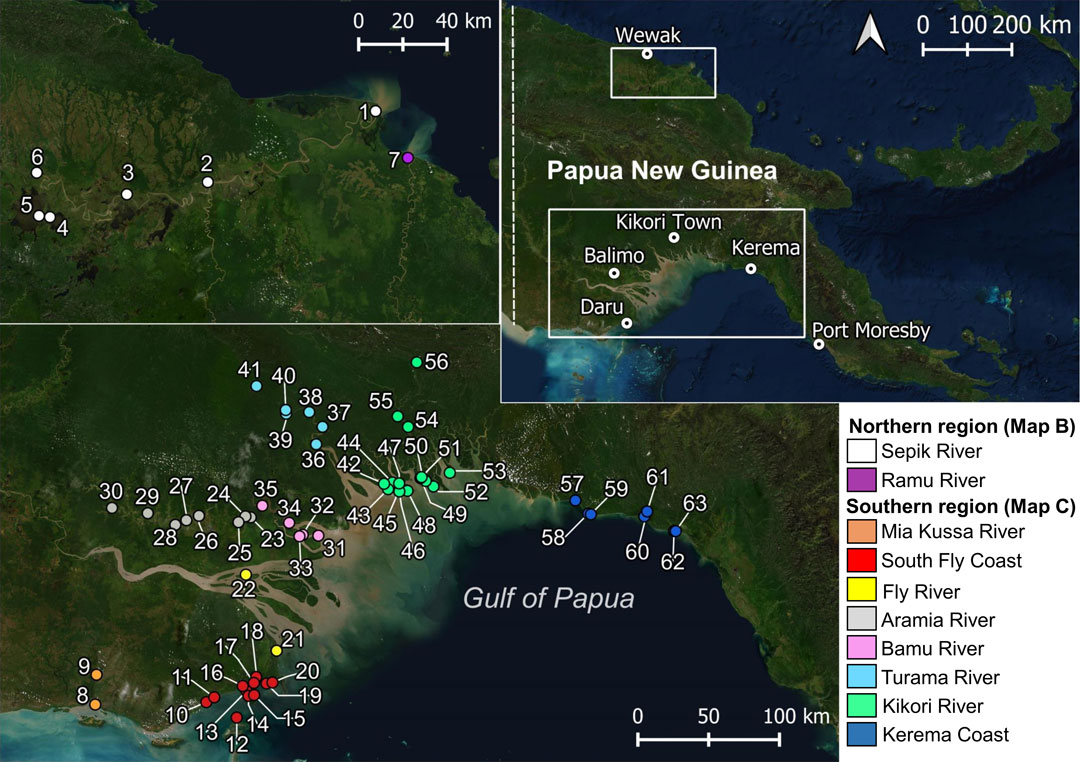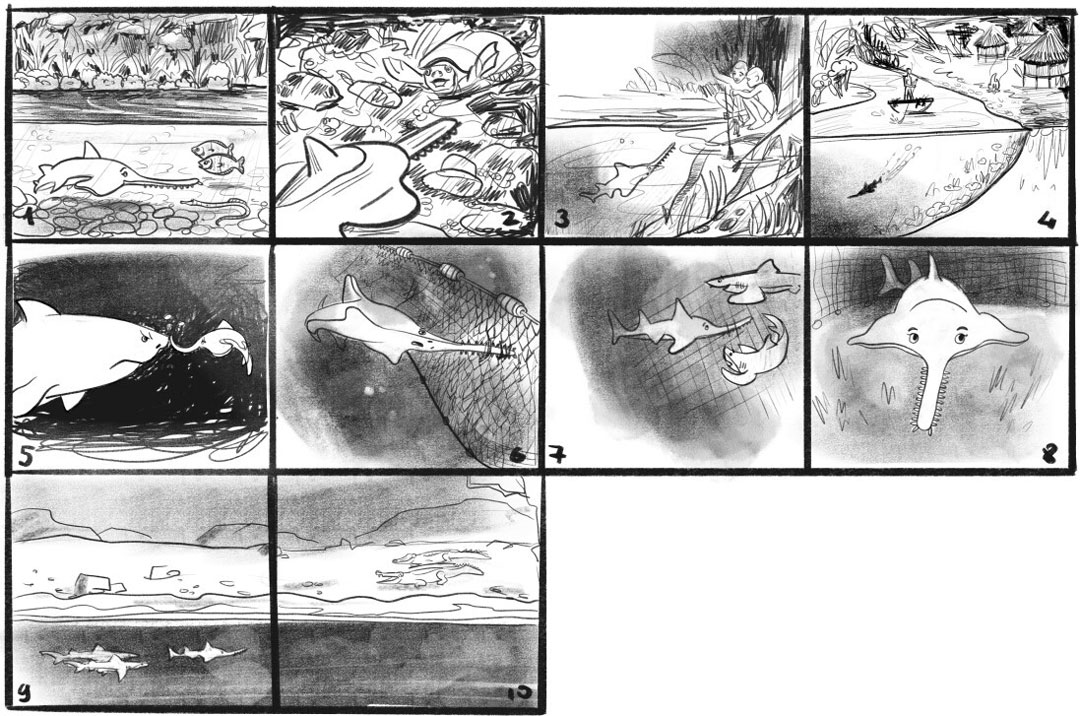Moving from conservation research to action
During the last six years, I have worked closely with a local NGO, the Piku Biodiversity Network, to research sawfishes in southern Papua New Guinea. Our initial focus had been on gaining an understanding of where sawfish occur and what their population status was relative to other global areas. This then led to developing an understanding of how sawfish fit into local culture with respect to uses and values and what the primary threats to populations in Papua New Guinea are. From this research, the situation became quite clear; sawfish are still far more abundant in Papua New Guinea than in other areas of the Indo-West Pacific (excluding central north and north-western Australia). However, their populations are declining primarily due to inshore gillnet fisheries pressure driven by the emergence of a lucrative fish maw (teleost swim bladder) fishery. We found that while some communities have cultural stories or practices involving sawfish, they are often opportunistically retained when incidentally caught for either consumption or sale of fins. An important distinction made during this research was that sawfish themselves do not have a large or significant contribution to food or economic security, and almost all fishers expressed support for their conservation, citing that it would be a shame to lose this iconic animal from Papua New Guinea’s rivers.
From our contemporary surveys and a compilation of historic records conducted by Dr William White and colleagues, the Gulf of Papua appears to be a bright spot for sawfish in Papua New Guinea. The Gulf of Papua can be characterised as a large shallow coastal shelf that several major river systems drain into, creating an expansive turbid estuarine habitat lined with dense mangrove forests – Perfect for sawfish. Furthermore, human populations in the Western and Gulf Provinces that border the Gulf of Papua are very low in human population density, and there are very few commercial activities. Therefore, there is great potential to secure the Gulf of Papua and its associated river systems as a sawfish refuge in the future. However, to achieve this, a great effort is required to stabilize current declines and secure sawfish habitat into the future.

Distribution of village communities in Papua New Guinea where records or anecdotal evidence of sawfish, along with river sharks (Glyphis) were made during surveys conducted in 2017–2020. Figure originally published in Grant, M. I., et al. (2021). "Papua New Guinea: A potential refuge for threatened Indo–Pacific river sharks and sawfishes." Frontiers in Conservation Science 2(48). Open Access https://doi.org/10.3389/fcosc.2021.719981
A factor in our conservation planning for sawfish is that in the provinces that border the Gulf of Papua, literacy and education rates are very low. A recent report compiled on indicators of basic education standards across Papua New Guinea found that Grade 8 examination results were lowest in the Western Province, while Gulf Province was the third lowest overall. Cohort retention rates in the Western (59%) and Gulf (55%) Provinces were also low compared to the rest of Papua New Guinea. Human populations in the Western and Gulf provinces highly rely on natural resources for day-to-day food and economic security. Fishing is the primary livelihood, and well as being the primary source of protein. Fishing is often conducted in customary lands, from villages and temporary fishing camps located away from towns or places of commerce where schools are typically located. It is apparent that children often leave school before their education is finished so that they can assist in family or community activities such as fishing or general village tasks. For example, in the Fly River Basin, Western Province, cohort retention rates in schools are far lower (52%) in the Middle and South Fly (River delta and southern coastline) Districts compared to the Northern Fly District. This is likely due to the limited number of towns and education services in the Middle and South Fly Districts requiring children and families to travel long distances to access schools.
Through discussions with the Piku Biodiversity Network, we decided that we would pursue conservation-themed outputs that additionally helped to address the systemic education issues in the Western and Gulf Provinces. The focus of our present project has been developing a children’s book. This book follows a narrative of a largetooth sawfish leaving its freshwater nursery environment and migrating down the river towards the ocean. Along the way, this character meets other charismatic fauna in Papua New Guinea’s rivers and faces challenges associated with human pressures, such as fishing and increased sedimentation from logging. We additionally included fact pages that overview sawfish biodiversity, explain why the rostrum is ecologically important to them, provide examples of the cultural significance of sawfishes to some communities, and outline major threats to populations in Papua New Guinea. While the narrative is written in simple language designed for a younger audience, the fact pages and various fact boxes included within the book appeal to older children or those with greater interest in the biological and ecological aspects of the environment. Producing a book that can connect with varied age classes was important, as many local schools have a mixed classroom setting whereby children from various age groups are taught collectively.

Initial story boarding conducted by Maria Golubieva for the children’s sawfish book narrative.

A fact page produced by Dana Maggacis providing examples of the role of sawfish in local culture in Papua New Guinea
Another key output of this project was the production of a safe release guide for sawfishes that is specific to the local fishery context. While various sawfish safe release guides exist, they are tailored to high-capacity western fisheries and have limited suitability to the gear used by fishers in Papua New Guinea. Furthermore, these guides typically encourage the cutting of nets to free entangled sawfish. While this is practical in western fisheries, a gillnet may represent a significant investment for Papua New Guinean fishers, and materials are rarely on hand to repair nets. In producing the safe release guide, we were fortunate to be able to discuss the release of sawfish with local fishers in the Kikori River, who provided detailed feedback on aspects such as how to position the animal between the boat and the top line of the gillnet, and what materials such as rope are typically on hand to assist. Many fishers simply amputate the rostrum to untangle animals regardless of whether they intend to retain them for consumption or sale. It is hoped that the safe release guide, coupled with information on why the rostrum is ecologically important to sawfish, will lead to higher release rates and improve post-release mortality.

Sarah Hill working on development of a safe release guide for sawfish in Papua New Guinea’s small-scale gillnet fishery
To produce these materials, a team with diverse expertise was engaged. Yolarnie Amepou, director of the Piku Biodiversity Network, provided cultural advice and ground truthing and helped to ensure the material was appropriately educational to engage young children and be useful in classroom settings. A graphic design company, Chunky Duck, was engaged in leading the creative and graphical elements of this project. This included Sarah Hill, who was the chief producer and led the writing of the narrative, and Dana Maggacis, who helped develop the safe release guides and fact sheets. Maria Golubieva, an illustrator based in Europe, was additionally engaged to illustrate the graphical elements of the book. I, with help from Dr Madeline Green from the University of Tasmania, provided scientific input and ensured the narrative and other information provided were factual and informative for the local environments and threats in Papua New Guinea. We additionally reached out to the Sawfish Conservation Society, who provided general advice taken from their experiences of developing educational and outreach material for sawfishes.
The next phase of our ongoing conservation action initiative will be to disseminate the material and work towards raising public awareness of sawfishes through promotional activities and maintaining regular community presence via the Piku Biodiversity Network. Our team strives to change attitudes and behaviours towards sawfish interactions with fishers to facilitate actions that will help decrease non-essential fisheries interactions and conserve sawfishes in the Gulf of Papua region of Papua New Guinea.
